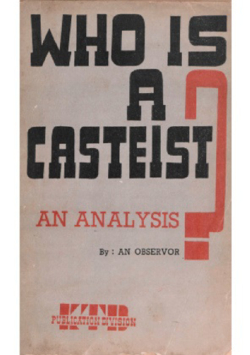"Who Is A Casteist? An Analysis" is an in-depth exploration of the concept of casteism within Indian society, authored to dissect the complexities and nuances associated with caste-based discrimination and social hierarchies. The book offers a critical examination of the term "casteist" and seeks to identify the traits and actions that define casteist behaviour.
The book begins with an introduction that sets the context for the discussion on casteism. It outlines the historical roots of the caste system in India and how it has evolved over time. The introduction provides a framework for understanding the pervasive nature of caste-based discrimination and the social, economic, and political dimensions of the caste system.
A significant portion of the book is dedicated to defining what it means to be a casteist. It examines the attitudes, behaviours, and practices that contribute to casteism. The author delves into various scenarios and examples to illustrate how casteist tendencies manifest in everyday life. This section aims to provide clarity on the often ambiguous and subjective nature of the term "casteist."
The book provides a historical analysis of casteism, tracing its origins and transformations over centuries. It discusses the role of religious texts, social customs, and colonial policies in shaping and reinforcing caste hierarchies. This historical perspective is crucial for understanding the deep-seated nature of casteism and the challenges involved in addressing it. The narrative moves on to explore the presence and impact of casteism in modern Indian society. It highlights the areas where caste-based discrimination is most prevalent, such as education, employment, and politics. The author discusses contemporary issues, including the reservation system, inter-caste marriages, and the role of caste in electoral politics.
Relationship Between "Who Is A Casteist? An Analysis" and Chaudhary Charan Singh
While the text itself does not explicitly focus on Chaudhary Charan Singh, its themes and analysis are closely related to his political ideology and actions, especially given his significant contributions to agrarian reform and his stance on social justice issues in India. The book's analysis of casteism includes the examination of social and economic policies that either reinforce or mitigate caste-based inequalities. Chaudhary Charan Singh's land reform policies aimed to break the hold of the upper-caste landlords over the rural poor, many of whom belonged to lower castes. By advocating for the rights of small and marginal farmers, Singh indirectly challenged the caste hierarchies that were deeply embedded in the agrarian economy. Chaudhary Charan Singh's political career was marked by his commitment to social justice and equality, principles that are central to the discussions in "Who Is A Casteist? An Analysis." His work in promoting the welfare of the rural poor and his stance against the concentration of land and wealth can be seen as efforts to reduce caste-based disparities. Singh's vision of an equitable society aligns with the book's call for legal and social interventions to combat casteism.
The book analyses various legal and social measures aimed at combating casteism. It reviews the effectiveness of laws and policies designed to protect the rights of marginalised castes and promote social justice. The author also explores grassroots movements and initiatives that have emerged to challenge caste-based discrimination and promote equality.
To provide a more tangible understanding of casteism, the book includes several case studies and personal narratives. These stories offer insights into the lived experiences of individuals who have faced caste-based discrimination and those who have worked towards caste equality. These narratives add a human dimension to the analytical discussions and underscore the real-world implications of casteism.
The book concludes with a summary of the key findings and a set of recommendations for addressing casteism. The author emphasises the need for a multi-faceted approach that includes legal reforms, educational initiatives, and societal change. The conclusion calls for greater awareness and collective action to dismantle caste-based discrimination and build a more equitable society.
1. Definition of Casteism:Clarifies what constitutes casteist behaviour and attitudes.
2. Historical Analysis: Traces the evolution of the caste system and its entrenchment in Indian society.
3. Contemporary Issues: Examines the persistence of casteism in modern India.
4. Legal and Social Measures: Reviews efforts to combat casteism through laws and social initiatives.
5. Personal Narratives: Provides real-life examples to illustrate the impact of casteism.
6. Recommendations: Offers solutions and strategies for addressing caste-based discrimination.
"Who Is A Casteist? An Analysis" is a comprehensive examination of casteism, offering valuable insights into the definition, history, and contemporary manifestations of caste-based discrimination. The book serves as both an academic resource and a call to action, urging readers to recognize and challenge casteist behaviours and work towards a more inclusive and just society.


